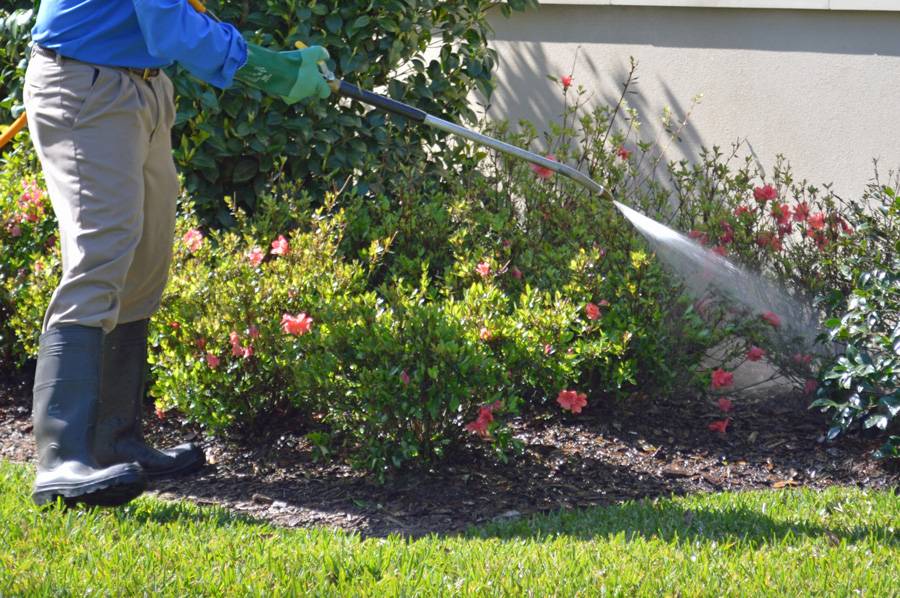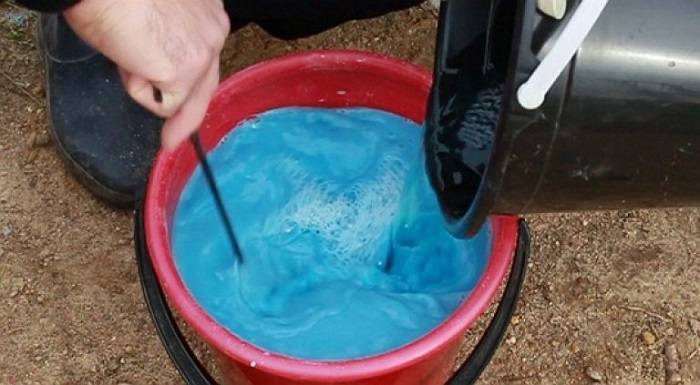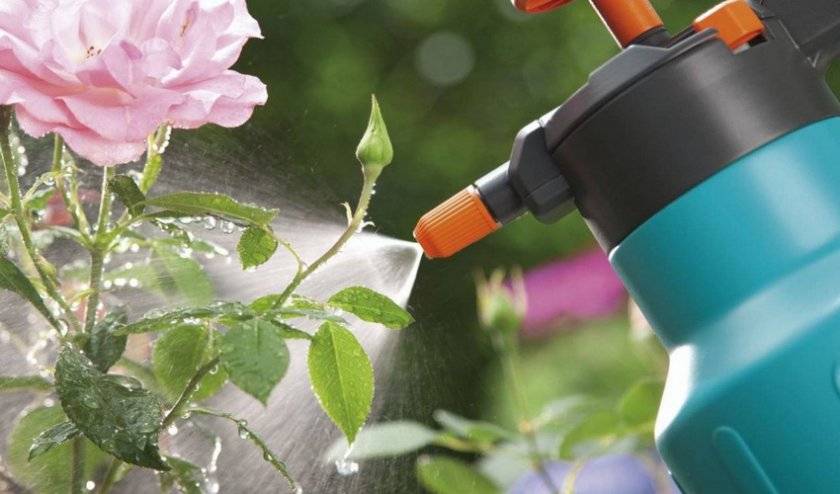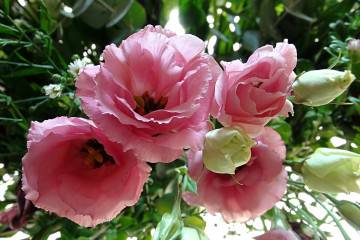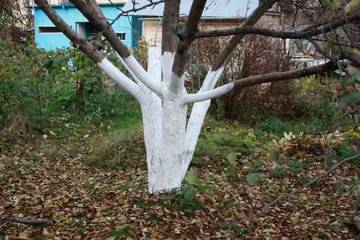How to treat roses from diseases and pests
Content:
Rarely are gardeners who have at least one rose bush on their site. These flowers do not leave you indifferent with their appearance and aroma. But in order to admire their abundant flowering, you must adhere to certain care rules and know how to process roses.
How to treat roses from diseases and pests
These flowers are susceptible to many fungal diseases, as well as attacks by ticks, caterpillars, aphids and other pests. Therefore, one of the main measures for caring for planting roses is treatment from diseases and pests. It is recommended to carry out the procedure from the beginning of spring, when the active growth of greenery begins.
In the question of how to process roses, the answer will depend on each specific case. For example, for preventive purposes, it is enough to use folk recipes based on lime, soap, wood ash and other components. For the treatment of diseases, as well as for the purpose of getting rid of insect pests, fungicides and insecticides are suitable. These drugs have a stronger effect and a wider range of applications. Therefore, before spraying roses, you should clearly define the purpose of this event.
How to properly handle roses
Before processing roses, flower growers are advised to study the recommendations regarding this procedure.
- before sprinkling with a solution of roses, it is necessary to clear the area of their growth from debris, old grass and weeds;
- the best time is a warm and calm day;
- it is best to do the processing in the morning or evening, so as not to burn the bushes under the scorching sun;
- before processing in the spring, you should feed the flowers, which will increase their immunity. This can be a urea solution or bird droppings. As mineral additives, it is worth considering potassium sulfate and superphosphate;
- processing roses involves spraying them with a working composition. For convenience, gardeners use a spray bottle;
- the solution is prepared in strict compliance with the proportions. Both a deficiency and an excessive amount of the active ingredient can have a detrimental effect on plants.
How to process roses for prevention
In the question of how to spray roses as a preventive measure, Bordeaux liquid has long been in the lead. It has a versatile composition that allows you to effectively fight against bacteria, fungi and insect pests.
Its main components are slaked lime and copper sulfate. They not only endow the plant with protective properties, but also promote growth and proper development. Bordeaux liquid after spraying roses stays on the leaves for a long time, which provides long-term protection.
Throughout the season, several preventive treatments are carried out with this agent:
- in the first spring month (March), the shrubs are opened from the winter shelter. At this time, when the kidneys are just beginning to swell, the first prophylactic treatment is carried out with a 3% solution. It aims to prevent fungal and bacterial diseases;
- in May, June and early autumn, the treatment is repeated, only a weaker 1% solution is used for this;
- in the summer, during the flowering period, spraying should be excluded, since the Bordeaux liquid is quite toxic to flowers;
- the best time for processing is a cool and dry day.
The most common pests of roses
The greatest danger is posed by insect pests during the growing season, which occurs at the end of March - beginning of April. At this time, roses are especially in need of protective measures.
Aphid
It settles on flowers in whole colonies, preferring young shoots and buds. Aphid larvae are extremely difficult to spot due to their small size, but they grow quickly. After 1-1.5 weeks, they reach puberty, which allows them to lay new eggs.
These insects feed on plant sap, and due to their rapid reproduction, they can seriously harm the shrub. One can suspect their invasion by twisted leaves, young shoots, and also by a large accumulation of ants that feed on the juice secreted by aphids.
Rose leafhopper
It is widespread and can cause serious harm to the rose garden. It is possible to recognize its appearance by the white dots covering the leaf plates, as well as by yellowed and fallen leaves.
By autumn, adult females lay eggs on the shoots. When winter ends, larvae emerge from them. They are small white caterpillars that feed on plant sap. If you touch them, they quickly jump to another place.
Spider mite
The most common and dangerous pest. Adults grow up to 0.5 mm in length, have a rounded body and 4 pairs of paws. If in summer their color is predominantly green, then by winter it changes to orange and even red.
The female spider mite lays up to 200 eggs, which turn into larvae in a week, and after 2-3 weeks they are able to reproduce themselves. The greatest damage from these insects occurs on the underside of the leaf blades. They suck out juices, which as a result leads to metabolic disorders, yellowing and leaf fall. In addition, mites, in the course of their vital activity, emit a fairly large amount of excrement, which retains dust and other contaminants. As a result, rose bushes quickly lose their decorative qualities.
Sawflies
Roses are susceptible to two varieties of sawfly: white-belted and descending. The latter is the most common. The larvae of these insects spend the winter in the upper layers of the soil, after which, with the onset of spring, pupate and turn into adults.
The sawfly has a length of 5-6 mm, a black shiny body and dark wings. Outwardly, in shape and structure, it is similar to a bee. Eggs are laid on the top of the young shoots. The larvae that are born quickly gnaw a passage in it, where they continue their development. The damaged part of the rose darkens and begins to dry out. Towards the middle of autumn, the larvae descend into the ground for further wintering.
How to treat roses from diseases
The first treatment is done after opening the bushes after winter. It is often called blue spraying, since Bordeaux liquid is used in combination with copper sulfate at this time.This composition is rich in copper and therefore has a blue tint.
In the future, the following preparations are used to treat roses:
- abiga peak. The main active ingredient is copper oxychloride. The tool has proven itself well in the treatment of powdery mildew, rust, all types of spotting, as well as bacteriosis. At the same time, abiga-peak is safe for beneficial insects;
- oxyhom. Combines two active ingredients: oxadixyl and copper oxychloride. It has a contact and systemic effect. Due to its rapid absorption into plant tissue, it can be used in rainy weather;
- HOM. An effective preparation against insect pests, which are susceptible to rose bushes. Dry weather treatment is preferable as the product can be washed off with water. Does not pose a danger to beneficial insects;
- cuprolux. The drug of complex action is made on the basis of cymoxanil and copper oxychloride. Effective for powdery mildew, rust, spotting and other diseases;
- confidor. Systemic insecticide with a contact-intestinal effect on insects. Recommended for use in case of mass infection.
Popular folk remedies
How to spray roses from diseases and pests with folk remedies:
- soap solution. Rubbed with 5 tbsp. tablespoons of laundry soap, diluted in 1 liter of warm water and poured into a spray bottle. Spraying is good after rain at intervals of 2-3 weeks;
- ash broth. To prepare it, you will need 200 g of ash to be introduced into 5 liters of water. Put on low heat, bring to a boil and boil for 2 hours. After the broth has cooled, it is filtered and used in processing;
- tobacco dust. A glass of this dust is poured with 2 liters of water, put on the fire and boiled for 30-40 minutes, after which it should be allowed to brew for 1-1.5 days, add the same amount of water and add 2-3 tbsp. tablespoons of crushed soap;
- cola and alcohol. To prepare this effective protection against aphids, you will need to pour a bottle of Coca-Cola into any container and leave it for a day. This is necessary so that the maximum amount of gas is removed from the drink. Then add half a glass of vodka and 5 tbsp. tablespoons of crushed laundry soap. In combination with each other, these components have a detrimental effect on insects.
Calendar of rose treatments from pests and diseases
Particular attention in the issue of treatments should be paid in the spring months, namely in March, when the winter shelter is cleaned, special supports are installed, as well as the hilling of the bust area. Flowers should be treated with Bordeaux liquid or iron vitriol.
In April, it is worth carrying out preventive treatment, since at this time the risk of an invasion of insect pests and the appearance of many diseases increases. At the same time, it is recommended to spray not only the plant itself, but also the adjacent territory.
Errors in the seasonal processing of roses
Often, when processing roses, inexperienced gardeners can make the following mistakes:
- spraying without prior pruning. The main condition for the spring procedure is to remove frozen, damaged and old shoots and only then start processing;
- work in wet weather. Many drugs are not effective in the presence of moisture or condensation on the leaves, therefore, spray should only be carried out in dry weather;
- processing during the day. The active sun can cause burns to shrubs, so work is postponed to the morning or evening hours.
Processing roses is the most important procedure for caring for them.With its help, you can get rid of annoying insects, prevent many diseases and heal already infected bushes.

